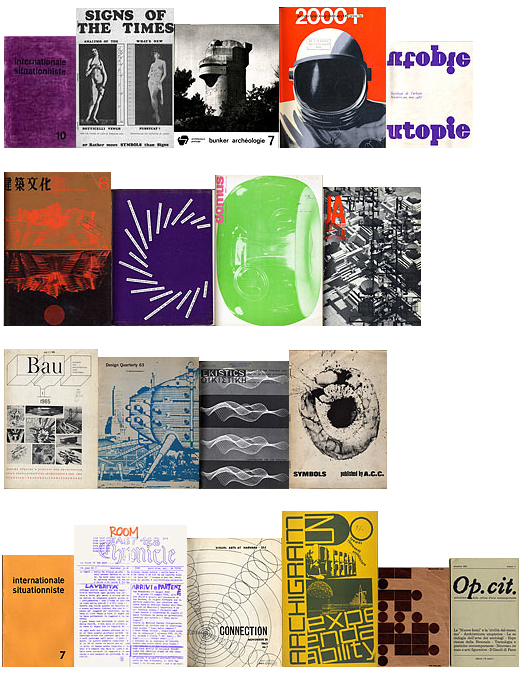Monday, January 17. 2011
ARCHI ZINES
Via Manystuff
-----
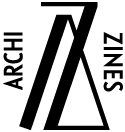
ARCHI ZINES is a showcase of international fanzines, pamphlets and journals that provide an alternative discourse to mainstream architectural publishing. Launched by Elias Redstone and Folch Studio, the project celebrates and promotes publishing as an arena for architectural commentary, criticism and research, and as a creative platform for new photography, illustration and design.
Alternative publishing has had a dynamic and important relationship with architecture over the years, with prolific moments in the 1960s, 1970s and 1990s. A recent resurgence has seen new titles emerge in countries around the world, from Argentina, Belgium and Chile to the UK and USA. ARCHI ZINES brings together this international collection of publications for the first time as an important resource for architects, designers, critics, photographers and anyone interested in discussing the buildings and spaces we inhabit.
Tuesday, July 13. 2010
Clip/Stamp/Fold - The Radical Architecture of Little Magazines 196X-197X
Via WMMNA
-----
Clip/Stamp/Fold: The Radical Architecture of Little Magazines 196x-197x is a traveling exhibition that started its journey at Storefront for Art and Architecture in New York City back in 2006, flew to Montreal, Oslo, Kassel, Murcia, Vancouver and London. It has now landed at NAiM/Bureau Europa in Maastricht (NL.)
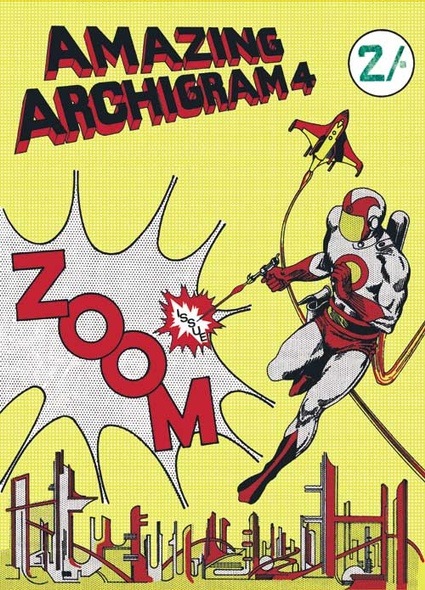
Cover illustration of the fourth issue of Archigram magazine. Credit: Archigram
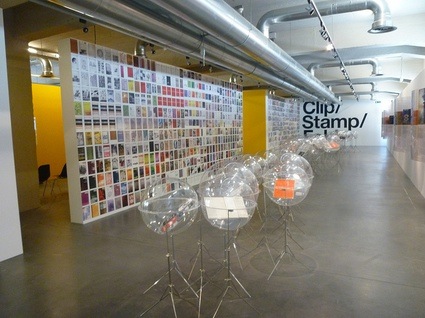
View of the exhibition space
Clip/Stamp/Fold chronicles the eruption on the architecture scene of the 1960s and 1970s of architectural little magazines that challenged the discipline and saw it as a space for experimentation and debate. The term "little magazine" doesn't refer to the size of the publications. It was coined in the mid-twentieth century to designate progressive literary journals, produced without concern for immediate commercial gain.

Casabella no. 367, July, Milan
The exhibition was conceived by architectural historian Beatriz Colomina whose fantastic work i discovered 2 years ago through one of her books Domesticity at War. She researched the Clip/Stamp/Fold show together with her architecture students at Princeton University. More recently, Colomina sent some of them to Playboy's archives in Chicago to investigate the critical role that the magazine played in promoting modern architecture and design in the '50s, '60s and '70s. I wouldn't mind a book or exhibition describing the result of that exploration.
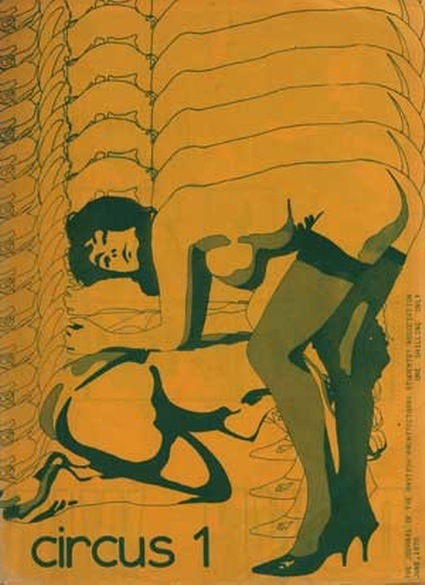
Circus no. 1, London
Many of the radical magazines featured in the exhibition were self-published and short-lived, they were written by dissatisfied student, architects who championed a more political approach to buildings and cities, theoretician, etc. Others are commercial and professional magazines still printed today that, at some point in their history, were influenced by the graphics and discussions of their avant-garde contemporaries. In addition to a selection of rare originals displayed inside plastic bubbles, and a timeline following the evolution of little magazines over two decades, the exhibition screens video interviews with some of the editors involved.
The covers and names of the magazines have a punk attitude that still attracts the eye, their content ranged from the presentation of experimental architecture to dry theory and articles akin to political pamphlets. Some critics have claimed that the energy and inventiveness of that era has long been glamored away by swanky design and glittering starchitects. I'm not so sure of that, sometimes i have the feeling that blogs such as BLDGBLG bring a new spin on the architecture discourse by the way they constantly and often unexpectedly go back and forth from past and future and introduce in the discussion ideas from different disciplines and perspectives.
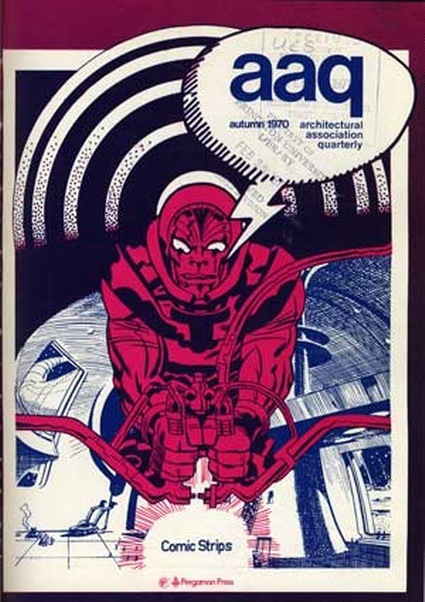
Architectural Association Quarterly, Autumn, London
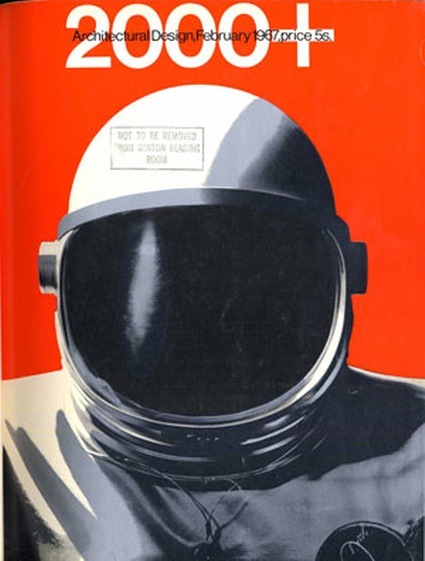
Architectural Design, February, London
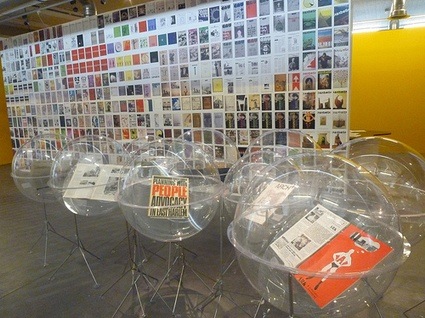
It was interesting to see how much Archigram popped up throughout the exhibition. Not only because they had some of the most flamboyant and catchy graphics but also because of the way other magazines would refer to their work.
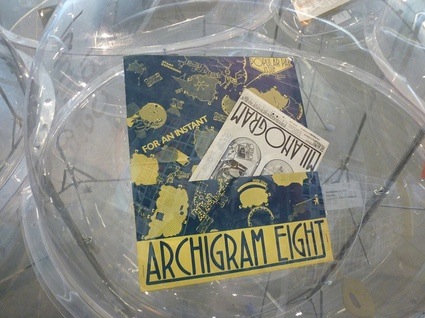
From Ron Herron's 1964 Walking City advancing onto the cover of both Aujourd'hui: Art et Architecture and Design Quarterly in 1965....
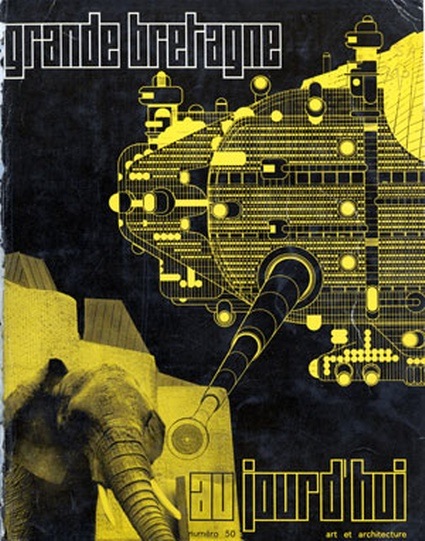
Aujourd'hui: Art et Architecture no. 50, July, Paris
To the photomontage on a cover of ARse from 1971. Much more critical, this one stars Peter Cook commenting a drawing of Archigram's first commissioned project, the Monte Carlo Entertainments Centre, to other members of Archigram. The sub-title "Archigoon Wins at Monte Carlo" implicates Archigram as part of contemporary architecture's fixation on consumer culture at the expense of social issues, during a time, ARse argued, that demanded architects' political engagement.
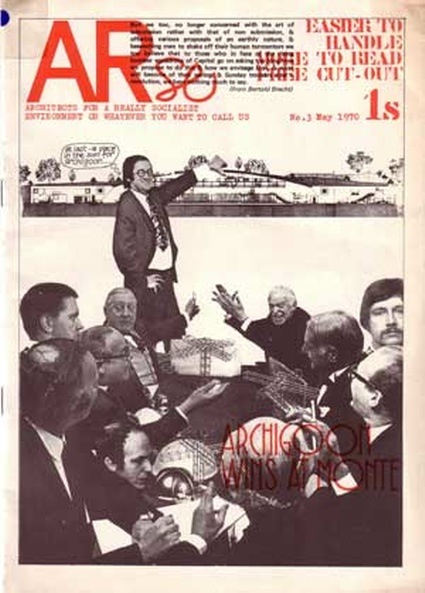
ARse no. 3, London
By the way, the elegantly-named title ARse was the acronym for a variety of words that changed from issue to issue - "Architects for a Really Socialist Environment," or "Architectural Radicals, Students & Educators" - but was always followed by the invitation, "Or Whatever You Want to Call Us."
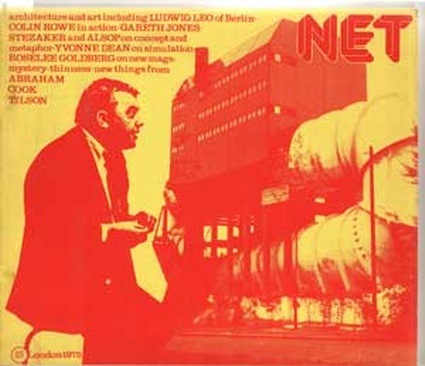
Net no. 1, London
Every new installation brings a local or regional addition to the core of the exhibition. The stopover in Maastricht extended the focus to Dutch magazines published from the 80s up to the present, in an attempt to investigate how little magazines continued to act as vehicles of critical expression after the '70s.
Volume reviewed the opening of Clip/Stamp/Fold in Maastricht.
The images i took are on flickr.
Clip/Stamp/Fold: The Radical Architecture of Little Magazines 196x-197x is at NAiM/Bureau Europa in Maastricht until September 26, 2010.
Friday, February 26. 2010
Vague Terrain 16: Architecture/Action
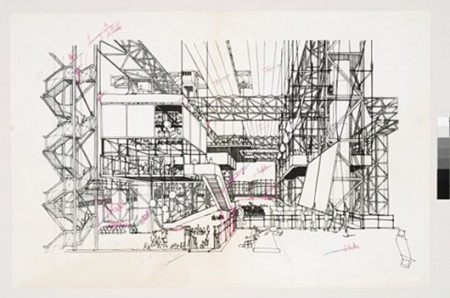
Joshua Noble’s new issue of Vague Terrain is definately worth a look. He described this issue as “an exploration of space, functionality in space, and the relationship of the body to the systems around it. All technologies reshape the body and the space around the body, from the bow and arrow to the steam engine to the telephone. It may be that we are beginning to truly see how computing and ubiquitous devices will once again reshape our bodies and our conceptions of ourselves in space. It is with this emphasis that we present a selection of thinkers, artists, architects, and designers and examine and explore how their ideas will shape art, aesthetics, design, living spaces, and social structures and how those ideas will ultimately be shaped by their users and their spaces.”
Articles have been written by Golan Levin, Jonah Brucker-Cohen, Marilena Skavara, Mark Shepard, Pierre Proske and Joshua himself.
-----
Related Links:
Monday, November 23. 2009
Landscapes of Energy
 Tonight in Cambridge, Massachusetts, New Geographies will be kicking off its second issue, "Landscapes of Energy," with a launch party and panel discussion. The new issue includes many contributors, ranging from Kazys Varnelis and Mirko Zardini to the Center for Land Use Interpretation and Carola Hein, and it was edited by Rania Ghosn.
Tonight in Cambridge, Massachusetts, New Geographies will be kicking off its second issue, "Landscapes of Energy," with a launch party and panel discussion. The new issue includes many contributors, ranging from Kazys Varnelis and Mirko Zardini to the Center for Land Use Interpretation and Carola Hein, and it was edited by Rania Ghosn.
 [Image: Some page spreads from the new issue, designed by Thumb].
[Image: Some page spreads from the new issue, designed by Thumb].
Things kick off at 5pm tonight—Friday, November 20—in Piper Auditorium, Gund Hall, 48 Quincy Street, Harvard. Be sure to stop in and say hello!
-----
Via BLDGBLOG
Personal comment:
Signaled by Geoff Manaugh from BLDBLOG: the launch of the second issue of a magazine (New Geographies) about speculative/critical geography that looks interesting.
Monday, June 15. 2009
Energies and Boundaries
A new issue of AD was recently published titled ENERGIES: New Material Boundaries, edited by Sean Lally of WEATHERS. This edition focuses on the rich, yet overlooked, territory of design that foregrounds the effects of material energies on boundaries of environments. Boundaries are taken to mean atmospheric thresholds that are the result of material decisions. This refers to the transition in air quality, illumination, temperature, olfactory concentrations, acoustics, among others, that permeates interior environments. Serving as an upgrading of Banham’s Well-Tempered Environment, ENERGIES consists of essays and projects that position the design of these often nearly invisible yet sensed conditions at the center of a contemporary debate between sustainability and atmospherics.
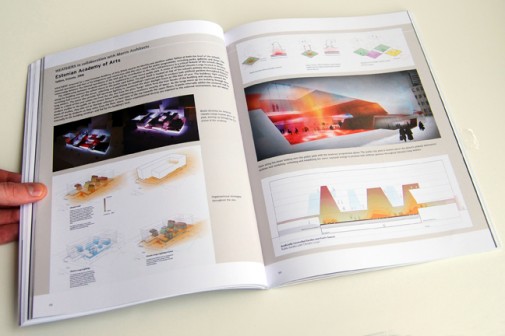

With so many technologies developed that are at the service of modulating our interior environments, it is little wonder that designers have marginalized their role to a perfunctory performance-based criteria - a “best practices” model. Or as Lally writes in his introduction:
… [W]hen it comes to one of the most prevalent and ubiquitous materials to influence architecture and its adjacent disciplines in the last thirty years – energy – we’ve made only stunted attempts to explore its design possibilities.
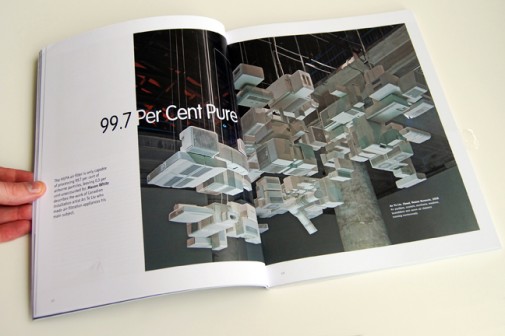
Sean and An Te Liu had invited me to write a text on Liu’s recent work embodied by the climate-controlling megastructure “Cloud” found in the 2008 Venice Biennale in Architecture. The idea of boundaries in Liu’s work is about invisibility. It explores the boundary of clean air from dirty, and varying degrees of processed air, and the psychological effects of that invisibility.
I recommend picking up a copy of the issue if you are interested in topics of modified environments, atmospherics, and the future of interior environments. Texts by Penelope Dean on green-washing and Michelle Addington on the illusive hermetic seal of building envelope round out a fantastic and thorough issue.
-----
Via InfraNet Lab
Personal comment:
Un magazine qui traite dans son dernier numéro de "nouvelles" dimensions spatiales. Avec pour les 3 images/projets publiées ici, 3 projets ou architectes déjà publiés dans ce blog: Philippe Rahm, An Te Liu et Marina Nicollier (diploma work).
Friday, March 06. 2009
Archinect and InfraNet Lab are previewing the first issue of [bracket], On Farming. Coming out...
Archinect and InfraNet Lab are previewing the first issue of [bracket], On Farming. Coming out Winter 2009, it's gonna be awesome. Go see.
-----
Via Pruned
Related Links:
Personal comment:
On avait parlé de cette future revue avec appel à articles derrière laquelle semble être Archinect. Le contenu annoncé des articles semble annoncer une revue aux thématiques assez expérimentales et intéressantes.
Wednesday, December 10. 2008
La Planète Laboratoire
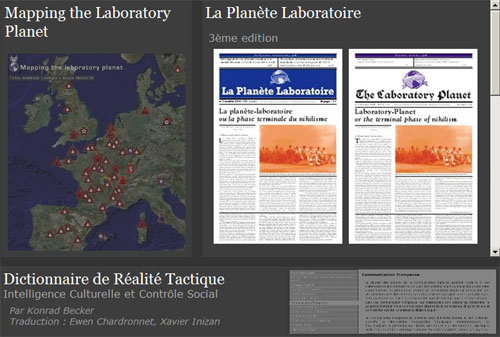
-
Un nouveau journal, expérimental et développant des thématiques contemporaines pour le moins pointues aux titres évocateurs: "Le destin du psychonaute occidental", "Comment les Cyborgs ont appris à ne plus s'en faire et aimer la surveillance", "Molécules de combat", "Le vaudou planétaire", "La planète-laboratoire ou la phase terminale du nihilisme", etc.
En versions imprimées anglaise et française au prix de 2.-€, ou plus simplement téléchargeables en pdf sur le site.
P_
-----
Via fabric | ch
Related Links:
Personal comment:
Mentionné en vue du prix Transmediale 2009 (thématique: Deep North). Ewenn Chardronnet fait partie du comité de rédaction, il organise le prochain festival Futur(s) en Seine à Paris (fabric | ch y sera invité à produire une pièce) et c'est lui qui avait écrit un article il y a quelques années sur le projet i-Weather, travail conjoint entre fabric | ch et Philippe Rahm.
Tuesday, October 28. 2008
Bracket Magazine
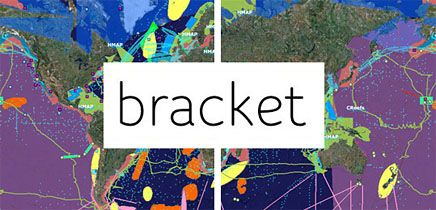 |
| Archinect Weekly - October 27, 2008 Archinect is proud to announce [bracket] [bracket] is a collaboration of Archinect and InfraNet Lab, and is composed of a collection of diverse editors and an open-source contributing membership. [bracket] is an annual publication documenting issues overlooked yet central to our cultural milieu that have evolved out of the new disciplinary territory at the intersection of architecture, landscape, urbanism and, now, the internet. It is no coincidence that the professional term architect can also now refer to information architects, and that the word community can also now refer to an online community. [bracket] is a publishing platform for ideas charting the complex overlap of the sphere of architecture and online social spheres. Seeking new voices and talent, [bracket] is structured around an open call for entries. The series will look at thematics in our age of globalization that are shaping the built environment in radically significant and yet unexpected ways. The first issue is titled On Farming is to be released in Fall 2009. [bracket] would like to thank the Graham Foundation for support. Please visit the [bracket] website for a description of the call for entries, schedule, and how to be part of future mailings. And please pass this on to anyone you believe could be interested to participate or submit ideas, designs, or texts. |
Related Links:
Personal comment:
Un nouveau magazine avec appel à contributions. Et un "discours" qui peut rappeler les débuts de fabric | ch ... Il y a plus de 10 ans.
Tuesday, October 14. 2008
Art Review's Power 100
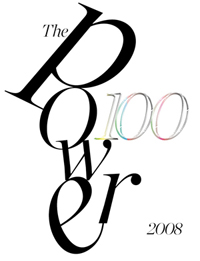 The November issue of ArtReview magazine, with the 2008 Power 100, will be available at the Frieze Art Fair on Wednesday 15 October, and on newsstands everywhere the next day.
The November issue of ArtReview magazine, with the 2008 Power 100, will be available at the Frieze Art Fair on Wednesday 15 October, and on newsstands everywhere the next day.
'The art world's equivalent to the Forbes 100' – Reuters
Now in its seventh year, the Power 100 assesses the titans of the artworld at a time when contemporary art's appeal has never been greater – and the stakes have never been higher.
The ArtReview Power 100 looks at the artworld not according to what it shows, but who it is. The list is a highly visible barometer in an otherwise opaque industry, letting you know who's deciding what you see, and telling you a little about why.
The 2008 Power 100
| 01. Science (Damien Hirst) 02. Larry Gagosian 03. Kathy Halbreich 04. Sir Nicholas Serota 05. Iwan Wirth 06. Jay Jopling 07. David Zwirner 08. François Pinault 09. Jasper Johns 10. Eli Broad 11. Jeff Koons 12. Steven A. Cohen 13. Daniel Birnbaum 14. Charles Saatchi 15. Brett Gorvy & Amy Cappellazzo 16. Tobias Meyer & Cheyenne Westphal 17. Marian Goodman 18. Gerhard Richter 19. Richard Prince 20. Dominique Lévy & Robert Mnuchin 21. Michael Govan 22. Marc Glimcher 23. Annette Schönholzer, Marc Spiegler 24. Alfred Pacquement 25. Matthew Slotover & Amanda Sharp 26. Barbara Gladstone 27. Matthew Marks 28. Takashi Murakami 29. Agnes Gund 30. Sheikh Mohammed bin Zayed al Nahyan 31. Dakis Joannou 32. Bernard Arnault 33. Richard Serra 34. Sadie Coles 35. Julia Peyton-Jones & Hans Ulrich Obrist 36. Donna De Salvo 37. Simon de Pury 38. Don & Mera Rubell 39. Ann Philbin 40. Paul Schimmel 41. Patricia Phelps de Cisneros 42. Michael Ringier 43. Jose, Alberto & David Mugrabi 44. Chris Kennedy 45. Bruce Nauman 46. Cy Twombly 47. Ai Weiwei 48. Tim Blum & Jeff Poe 49. Andreas Gursky 50. Olafur Eliasson |
51. Harry Blain & Graham Southern 52. Jeff Wall 53. Peter Doig 54. Roman Abramovich & Daria Zhukova 55. Bruno Brunnet, Nicole Hackert, Philipp Haverkampf 56. Marlene Dumas 57. Gavin Brown 58. Victoria Miro 59. Mitchell Rales 60. Yvon Lambert 61. Mike Kelley 62. Paul McCarthy 63. Banksy 64. Emmanuel Perrotin 65. William Acquavella 66 .Lucian Freud 67. Victor Pinchuk 68. Maurizio Cattelan 69. Cai Guo Qiang 70. Maureen Paley 71. Roberta Smith 72. Peter Schjeldahl 73. Thelma Golden 74. Ralph Rugoff 75. Robert Gober 76. Iwona Blazwick 77. Richard Armstrong 78. Massimiliano Gioni 79. Jerry Saltz 80. Reena Spaulings/Bernadette Corporation 81. Louise Bourgeois 82. Cindy Sherman 83. Okwui Enwezor 84. Jeanne Greenberg Rohatyn 85. Shaun Caley Regen 86. Liam Gillick 87. Miuccia Prada 88. John Baldessari 89. Francesca von Habsburg 90. Christian Boros 91. Nicholas Logsdail 92. Subodh Gupta 93. The Long March Project 94. Paula Cooper 95. Peter Nagy 96. Casey Reas 97. Anita & Poju Zabludowicz 98. Guy & Myriam Ullens 99. Laurent Le Bon 100. Thomas Kinkade |
Check out lists from previous years here:
2002, 2003, 2004, 2005, 2006, 2007
Entrants on the Power 100 list are judged on the following four criteria, each of which carries a 25 percent weighting.
1. Genuine influence over the production of art: entrants must exert influence over the type, style and shape of contemporary art being produced in the previous 12 months.
2. Influence on an international scale: as the list is international, entrants must exert influence on a global scale rather than as big fish in small-to-medium ponds.
3. Financial clout: entrants are judged on the extent to which they have shaped, moulded or dominated the art market, whether as artists, dealers or collectors.
4. Activity within the last 12 months: entrants are judged on having actually done something during the period September 2007 to August 2008. It's not enough to sit on your powerful behind.
Related Links:
Personal comment:
Tous nos potes! ;) Entrée "surprenante": Casey Reas (Processing) en nr 96.
Wednesday, August 20. 2008
Clip/Stamp/Fold
Clip/Stamp/Fold:
The Radical Architecture of Little Magazines 196X – 197X
An explosion of architectural little magazines in the 1960s and 1970s instigated a radical transformation in architectural culture with the architecture of the magazines acting as the site of innovation and debate. Clip/Stamp/Fold takes stock of seventy little magazines from this period, which were published in over a dozen cities …
from manystuff.org
fabric | rblg
This blog is the survey website of fabric | ch - studio for architecture, interaction and research.
We curate and reblog articles, researches, writings, exhibitions and projects that we notice and find interesting during our everyday practice and readings.
Most articles concern the intertwined fields of architecture, territory, art, interaction design, thinking and science. From time to time, we also publish documentation about our own work and research, immersed among these related resources and inspirations.
This website is used by fabric | ch as archive, references and resources. It is shared with all those interested in the same topics as we are, in the hope that they will also find valuable references and content in it.
Quicksearch
Categories
Calendar
|
|
July '25 | |||||
| Mon | Tue | Wed | Thu | Fri | Sat | Sun |
| 1 | 2 | 3 | 4 | 5 | 6 | |
| 7 | 8 | 9 | 10 | 11 | 12 | 13 |
| 14 | 15 | 16 | 17 | 18 | 19 | 20 |
| 21 | 22 | 23 | 24 | 25 | 26 | 27 |
| 28 | 29 | 30 | 31 | |||

